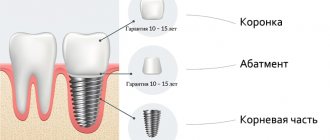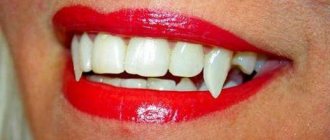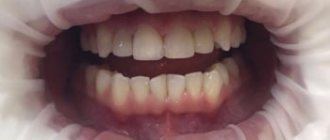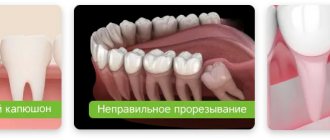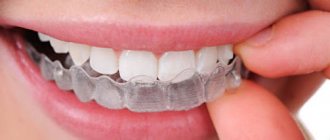The augmentation technique is one of the areas of dental restorative restoration of the dentition.
This measure can be either forced (for medical reasons) or aesthetic in nature.
This technology is considered one of the latest achievements of modern dentistry. It was first used by Japanese doctors, and is now successfully practiced by domestic specialized clinics.
The goal of the procedure is to make the tooth aesthetic and natural, so that everything looks natural, as close as possible to the original.
Options for teeth filing procedures
In some cases, your dentist may tell you during treatment that it would be advisable to file your teeth. There are controversial opinions about this procedure - some experts believe that it harms the teeth, others say it is completely safe. In this article we will try to figure out whether filing is harmful, whether it can be done, and in what cases a part of the tooth is ground down.
Cosmetic filing
If earlier, before the advent of modern filling materials, filing was a method of treating caries in dentistry by removing affected areas, today it is used for cosmetic purposes. Let's try to figure out what effect can be achieved if you file your teeth.
- A V-shaped separation of interdental spaces is performed. As a result, the gaps facing the vestibular side are smaller than those facing the oral cavity. This procedure must be carried out very carefully, having first studied the characteristics of tooth enamel, taking into account the crowding of teeth.
- By filing, you can achieve a more harmonious appearance of the front teeth, which have sharp corners. After the procedure, the ground incisors take on a more pleasant appearance.
- You can resort to it in case of minor damage to the enamel as a result of injury. Small chips are easily softened, allowing you to avoid a full restoration.
- There is such a feature as elongated front teeth that stand out from the general line. This is a cosmetic defect, which for many is associated with psychological discomfort. If it is strongly expressed, it can affect the quality of diction and interfere with a full meal. The problem is often solved by filing, without waiting for you to naturally grind down your teeth.
- Quite often you can hear that a patient’s teeth were “saved” in orthodontic practice. By removing a small layer of enamel from the sides, the orthodontist makes room for the teeth to be moved into the correct position using braces. This technique should be preferred if you have to choose between extraction and separation of teeth.
As you can see, no matter how many rumors there are about the harm of filing, it is quite common in dental and orthodontic practice. This means that, if necessary, you can agree to have it done without fear for the condition of your tooth enamel. We invite you to look at the photo, where you will find several examples before and after this procedure.
Why do you need to grow fangs?
The main task of the dentist is to recreate damaged tissues, replace lost teeth and restore their structure using onlays made of composite materials or prosthetics. After dental surgery, your smile should look as natural as possible. Anterior teeth augmentation is indicated in the following cases:
- the presence of chips and crevices,
- cracks and damage to enamel,
- congenital weakness of tooth enamel,
- wear of the enamel due to age-related changes,
- curvature of teeth and their irregular growth,
- pathological bite,
- traumatic injury,
- generalized caries,
- the formation of spots and defects of various sizes, shapes and colors on the enamel surface.
Filing before prosthetics
Before installing crowns or veneers, the enamel must be ground down. This procedure is significantly different from cosmetic filing and is called tooth preparation. If, in order to restore aesthetics, a small layer of enamel is removed, then before installing veneers, the treatment area is much larger.
Veneers and crowns are volumetric products. If you leave your teeth untouched, excess volume will appear. In addition, the design will not be able to fit harmoniously into the dentition. The natural shape of teeth is not ideal, so it is almost impossible to make crowns that fit them with maximum precision. That is why, with the help of grinding, excess volume is removed, bulges are eliminated, and the correct shape is given.
Veneers are installed with minor grinding, as they are thin. In the case of crowns, complete grinding is necessary on all sides. Dissection can be painful, so it is usually performed under anesthesia. When grinding, all tissue affected by caries is removed to eliminate the risk of secondary infection.
How much enamel will be removed during grinding? Don't worry about this. If you visit a really good specialist, only an acceptable layer of tissue will be removed. The first time after filing, increased sensitivity of the teeth may occur. Soon this phenomenon will disappear.
Now you can imagine how many indications there are for filing teeth. In the photo you have already seen what a cosmetic technique is. Grinding teeth for veneers looks completely different. The final video will introduce you to the veneer preparation procedure.
When should teeth be filed?
To make your teeth look attractive, your dentist will conduct a thorough examination of your mouth, after which he may recommend filing your teeth.
If earlier it was used in the fight against caries, now this event is carried out for cosmetic purposes. In what cases is this necessary:
- different heights of teeth;
- malocclusion;
- pathological abrasion of teeth;
- contact of the lower and upper jaws in multiple areas;
- early injuries;
- worn down teeth, which not only cause discomfort, but also cause serious oral diseases;
- high sensitivity to temperature, chemical or mechanical influences;
- chips and cracks.
If the above factors are present, filing problem teeth can be an independent procedure. If there is a need to wear braces, it will be a preparatory stage.
For wearing braces
To straighten the teeth, braces are prescribed.
The process is quite long, they generally need to be worn for at least two years. Before putting on the appliance, the doctor will perform a filing to remove a small amount of enamel from the sides of the incisor. This makes it possible to free up space for the teeth to move into the correct position. The technique is an excellent alternative to complete removal of incisors and separation.
Braces have been used in orthodontics for decades, and regardless of the type and material chosen, their action will be equally effective. They are manufactured separately for each patient, taking into account the individual characteristics of his physiology.
The design consists of small “locks” that evenly affect the teeth, gradually placing them in the oral cavity in the correct position.
Why do children have their fangs ground down?
From early childhood, teeth can erupt with various anomalies. Therefore, to avoid the development of defects, some areas should be filed. Basically, several factors contribute to the appearance of flaws:
- adenoids;
- congenital abnormalities;
- prolonged pacifier sucking;
- rickets;
- inflammatory processes in the oral cavity;
- bad habits (biting lips, cheeks, etc.);
- failure to maintain proper hygiene.
Grinding of fangs is carried out for high-quality treatment of anomalies of the dentition or individual areas. In orthodontics, this procedure is also used to organize a correct bite in children. There are no special age limits; the doctor first of all pays attention to the patient’s perseverance.
Read also: What is a temporary filling for?
Grinding of front teeth
Before carrying out the manipulation, the specialist assesses the general condition of the teeth. This is done in several ways: using wax plates, liquid aerosol, carbon paper. All existing irregularities, problem areas and enamel structure are examined.
The front teeth are ground down with a diamond bur if they protrude significantly. In more severe circumstances, a diagnostic model of the dentition is first created, and after a thorough examination they are filed down.
The procedure allows you to obtain an exact relationship between the lower and upper jaws and restore the bite. You can see the difference in the photo. During the rehabilitation period, you should limit the consumption of hot or too cold food. Trimming of incisors and chewing teeth is performed using other methods.
When is implantation needed?
Implantation is required if the root part of the tooth is damaged and cannot be used as a support for a prosthesis. This can happen when the side wall of the tooth is broken (below the gum level), deeply damaged by caries, root fracture, etc. In these cases, the tooth is completely removed and replaced with a titanium rod - an implant. Crowns are also placed on implants. These are metal ceramics and zirconium dioxide; ceramic prostheses are not used due to their high fragility.
Alternative ways to straighten teeth
There are several alternative methods for correcting dentition in modern medicine. The most common ones are:
- Orthopedic mouthguards. Made from plastic or silicone. They are convenient because they can be quickly removed at any time. This makes it easier to perform hygienic actions and eat food. They look aesthetically pleasing and are almost invisible in the mouth (they are mostly transparent).
- Aligners. Such devices are suitable even in advanced situations (severe crowding, curvature). It is noteworthy that when worn, the patient practically does not feel them and does not experience irritation.
- Trainers. They are used to treat children under 12 years of age; for minor curvatures, they must be worn for about 2 years. They are also used to consolidate the result after using braces and caps. Grinded incisors can be straightened by filling and using cosmetic procedures.
What is teeth filing and why is this procedure performed?
Sometimes a procedure such as teeth filing is required. What indications does it have for it, what changes occur before and after? We will indicate the prices for this dental procedure and reviews of patients who have undergone this method of treatment or correction.
Not everyone is naturally blessed with a perfect smile. In some cases, defects are only aesthetic and spoil the appearance of the smile, while in other situations they lead to more serious consequences. What exactly should be done in each case is decided by an experienced dentist or orthodontist.
Why canine teeth often grow crooked or do not erupt completely?
For most children, “threes” are the very last to appear - closer to ten or twelve years. Because of this, it may turn out that there is no place for them. Then they begin to grow higher than necessary, behind or in front of their neighbors.
Another common problem with crooked eye units is the discrepancy between the size of the teeth and the width of the jaw. This phenomenon is quite common - a child may inherit a small jaw from one parent, but large, large teeth from the other.
The third cause of dental anomaly is the delayed replacement of milk units with permanent ones. There is no way to influence her. You just have to eliminate the consequences of deviation.
Indications and contraindications
Doctors have been using this technology of filing individual units, that is, tooth preparation, as it is called in medicine, since the 19th century. But if earlier it was used as a treatment for caries, today it is used only for orthodontic correction of malocclusion, prosthetics or restoration of anterior teeth.
Only the doctor can decide in which cases filing will be a good choice. Although not all experts agree on the usefulness and desirability of its implementation, there are situations when it remains the only way to eliminate the defect:
- Fixation of the crown – to level the surface so that the prosthesis fits perfectly to the tooth. In this case, it is given the correct geometric shape and all sides are sharpened so that the hard fabrics and artificial material are in close contact, and the product does not stand out from the general range.
- Installation of veneers - in order for the plate to be firmly fixed and also look natural when smiling, you need to remove part of the enamel to fit its dimensions. In this case, only the front (vestibular) surface of the tooth is treated.
- Preparation for special inlays - in order to mask the formed voluminous cavities as a result of carious lesions, ceramic or metal products are installed. To ensure a tight fit to the remaining part of the tooth, the inner walls of the hard tissues should be carefully prepared.
- Orthodontic treatment of malocclusion is done in different cases. Sometimes it is necessary to file down part of the incisors to make room for the correct placement of all units without completely removing them. In other situations, molars are filed for convenient fixation of braces. This is especially true when the row is highly crowded.
- Minor injuries to the enamel - if chips have formed, then to correct the aesthetic appearance of the teeth, as well as to ensure the comfort and safety of the oral cavity, you need to carefully file down the injured part.
- Incisors are too long by nature - sometimes they protrude significantly and stand out from the crowd, spoiling a person’s appearance. Also, such a defect can negatively affect diction and the quality of food processing. By filing them, you can achieve evenness of the dentition and normalization of the bite.
- The presence of sharp edge surfaces - when the anatomical shape of individual units is far from ideal and injures neighboring tissues.
In pediatric dentistry, we encounter such a phenomenon as elongated fangs. This anomaly can be either congenital or appear from external influences, for example:
- in the presence of adenoids;
- from rickets;
- after sucking a pacifier for a long time;
- as a result of various inflammatory processes in the oral cavity;
- from the habit of biting lips or cheeks, etc.
Doctors try to rarely resort to such a procedure, since it is irreversible and not always useful. When making a decision, important contraindications should be taken into account:
- accelerated erasability;
- bruxism;
- increased sensitivity of enamel;
- bad habits such as opening bottles with teeth or excessive love for nuts and other hard foods;
- when the patient’s lifestyle involves a high risk of injury – boxing, wrestling, etc.
How is the procedure carried out?
The methods and place of influence themselves will differ from the purpose for which the filing is performed. It usually goes through the following stages:
- Preparation - the doctor examines the condition of the patient’s oral cavity, determines the presence of defects, and determines treatment methods and contraindications. If necessary, can carry out professional cleaning of surfaces before manipulation.
- They determine the area of influence - with special devices (copy paper, aerosol, wax plates) they mark the areas in which cutting is required. To do this, for example, they paint the area of high teeth (if their level is uneven) in a different color, so that in the process they do not make a mistake with the amount of sawed tissue.
- Direct preparation - depending on the purpose, the methods of treating the tooth will differ. So, if the chewing unit is ground down, then the upper tubercles are affected. And when processing incisors, multidirectional movements are needed.
Read also: Restore teeth
The final stage is always the polishing of surfaces and the procedure for remineralization of teeth. Thus, the edges of the enamel are made smooth and snow-white. And replenishing the structure of hard tissues with useful substances helps to strengthen them and protect them from any aggressive external influences. As a result, the tooth will remain healthy and intact even after such a procedure.
Prices
The cost of the service depends on the following factors:
- the selected material and its quantity;
- extension method;
- cost of work;
- specialist qualifications;
- status and prestige of the clinic;
Taking into account the described options, the price will vary in the range from 4-5 to 20-30 thousand rubles.
Therapeutic restoration costs:
- anesthesia - about 400 rubles;
- additional materials – 350 – 400 rubles;
- work of a specialist, taking into account the composite material – about 4 thousand rubles;
- finishing (grinding and polishing) - within 200 rubles.
When treating caries or removing stones, the cost will increase by the amount of services provided.
As for crowns, the price here will be significantly higher. And it is directly determined by the material chosen by the patient from which it will be made.
So, for example, a conventional design made of a metal alloy will cost about 3-4 thousand, and a product made of zirconium will cost about 20 thousand.
Important point! The price for the same type of composite produced in Russia will be 20-30% cheaper compared to foreign analogues.
Activities included in the group of additional and optional procedures will be paid separately. The final price of the service is influenced by the status of the establishment (this can increase the cost by 10-12%) and the region of the country - depending on the locality, its size and level of infrastructure, the cost can vary by up to 15%.
What complications can there be?
If no mistakes were made during the filing process, then of all the unpleasant consequences one can note only the appearance of increased sensitivity of the enamel for a short time. Therefore, doctors recommend avoiding in the first days foods that can cause increased irritability - hot, cold, sour, and brushing your teeth with a soft brush.
When discomfort does not go away after a week, you should consult a doctor for help. It is quite possible that some conditions were not met and the enamel surface was destroyed.
Is it harmful to file teeth? Since this involves removing part of the hard tissue, which is no longer formed again, most doctors consider this procedure not very useful. After all, it is irreversible and it will be impossible to return the tooth structure to its previous state. But in some cases this is considered almost the only available way to eliminate defects.
In addition, patients are often interested in the question, is it painful or not during the filing process? Since the impact on the tooth is most often noticeable and unpleasant, doctors use a local anesthetic for pain relief.
Rules of care
With a qualified restoration service, the service life of the renewed tooth is quite long , but it requires compliance with the following recommendations:
- use only a medium and soft toothbrush, choose a toothpaste without abrasive components, so as not to cause additional damage to the surface;
- do not smoke, avoid consuming foods and drinks that contain artificial coloring substances, since in case of pigmentation it will no longer be possible to return to its former whiteness;
- clean the surface at least 2 times a day, since artificial material is more susceptible to the appearance of plaque and stone;
- Once every six months, visit the dentist, carry out the procedure of polishing and coating with a special protective varnish.
Is it possible to do sawing at home?
Experts insist that performing such manipulations on your own at home is strictly prohibited. This is due to the fact that:
- To do this, a person does not have a special tool that acts on the surface of the tooth in a gentle manner.
- Under such conditions, it is impossible to accurately determine the volume of the removed area.
- When filing on your own, new chips and cracks in the enamel often appear, where bacteria quickly penetrate and lead to complete destruction of the tooth.
People who have tried to remove an aesthetic defect on their own at home turn to doctors. As a result, they have to take a long and painful time to treat damaged units, and sometimes remove them completely.
So, how much does such manipulation cost? Everything will depend on the type of procedure, purpose and scope of exposure. The cost in each case will be different:
- when treating carious cavities – 200-350 rubles per tooth;
- after/while wearing braces – 550-650;
- grinding the edge when a chip appears – 200-300 rubles;
- preparation of a unit for a crown – 130-200 per individual element;
- preparing the surface for installation of an orthodontic structure – 150-200 rubles.
Video: how to file teeth?
They filed down my tooth for a crown. Even with pain relief, I felt discomfort. This is a rather unpleasant procedure. But the main thing is that after this the product is installed efficiently, otherwise the exposed tooth will quickly collapse.
When I decided to get veneers, I understood that I would have to cut off part of the surface. But I don’t regret it at all, because my smile has become perfect. The most important thing in this is choosing a good specialist so that he does not damage your enamel.
After this treatment, I suffered from tooth sensitivity for a long time. I used pastes, rinses, etc. The doctor said that this was a normal reaction, since the nerve endings were left without protection. I hope that after the crown is installed, these sensations will go away.
Is it possible to file teeth if they are uneven?
A beautiful smile can be ruined by uneven teeth or long upper incisors, like those of a rabbit. You can fix the problem without removing them. You just need to file your teeth. How does this dental procedure happen?
This procedure is carried out in the following cases:
1. In case of malocclusion due to different heights of the teeth.
2. The presence of too sharp incisors, which can injure the tongue.
3. With multiple contacts between the teeth of the upper and lower jaw.
4. Presence of injuries and chips.
This procedure does not take much time. It is not performed to solve aesthetic problems - artistic restoration is suitable for this.
Filing is used if you need to correct minor errors that cause discomfort. Your dentist will tell you whether it is possible to file teeth in case of serious illnesses, such as caries.
The method of filing and grinding is not so harmless. The procedure is harmful to enamel and teeth. Sensitivity increases and cracks may appear. The enamel also wears off. But in some cases, filing cannot be done without filing, for example, to correct a deep bite.
Before filing the front teeth, the doctor first identifies problem areas and also assesses the condition of the enamel. You can identify irregularities in the dentition using carbon paper, a wax plate or a liquid aerosol. Problem areas are painted in a more intense color.
Teeth that protrude significantly are filed using a diamond bur. In severe cases, diagnostic models of the dentition are first made. After assessing their condition, diagnostic grinding is performed.
When filing chewing teeth, you need to smoothly remove the enamel from the dental cusps. When grinding cutters, a different technique is used. Filing occurs using versatile movements of the lower jaw relative to the upper.
For the first time after the procedure, you should refrain from eating hot or cold food.
Teeth filing is performed to obtain the correct relationship between the upper and lower dentition. The procedure also serves to restore the bite. Before the procedure, you need to weigh the pros and cons, because it has some side effects. Filing is an alternative to extraction for severely elongated front teeth.
Reasons for the development of pathology
Damage can be caused by several direct or indirect factors. Determining the cause is an important aspect for proper treatment. Among these factors:
- Mechanical damage due to trauma.
- Chipping due to bad habits (biting nails, pens, and other objects not intended for this purpose).
- Reduced acidity of the oral cavity, which negatively affects the strength of enamel.
- Bite defects.
- Dental pathologies that have not received treatment.
- Remineralized enamel.
- Hormonal imbalances, changes during pregnancy.
- Frequent consumption of excessively hot or cold foods.
- Night grinding of teeth.
In what cases is it necessary to file teeth?
Teeth filing technology has been used in dental practice since the beginning of the 19th century. At that time, this procedure was used as a preservative during the treatment of caries.
With the improvement of therapy methods and the expansion of the list of instruments used, this treatment technology was abandoned, however, in some situations, filing is still used.
The content of the article:
There are opposing opinions among dentists regarding the procedure, but there are situations in which filing is necessary:
- When installing crowns. For reliable fixation of the crown, it must fit tightly to the tooth surface. Since the anatomical shape of each molar or incisor is not ideal, grinding down of the upper layers of their hard tissue is required.
Read also: Componers and veneers difference
This allows you to give your own bone organ the correct geometric shape, thanks to which the manufactured product is firmly fixed and does not stand out among other elements of the jaw row. For fixing veneers. Ceramic plates fixed to the surface of your own teeth have a certain thickness.
Therefore, in order for the installed microprostheses to fit firmly and not protrude beyond the boundaries of the native units, a small amount of hard tissue is ground off from the vestibular side of the elements of the jaw row. Preparation for inlays. If it is necessary to mask the cavity formed as a result of carious lesions, ceramic or metal inlays can be used.
Their fixation requires the creation of side walls and the formation of the required depth near the cavity. In case of installation of an orthodontic structure. Cutting down a small thickness of the top layer of the tooth allows you to make room for correcting the position of the remaining elements of the row without the need to remove them.
In addition, this option is often used in cases of increased crowding of teeth, since it facilitates the placement of fastening elements of the bracket system on them. If there is damage to the enamel. Chips on the surface of the front incisors can be made less noticeable by slightly filing down the enamel.
This improves the aesthetics of the appearance of the jaw row and eliminates the need for composite restoration. In case of elongated incisors. If the front teeth are longer than the rest of the row, this can not only cause psychological discomfort, but also interfere with correct diction or complete chewing of food.
To solve the problem, in some cases, filing the length of organs protruding from the common line is used.
- At sharp angles. The anatomical structure of the anterior incisors is not always ideal. If there are sharp corners, dentists may recommend filing them down, which will increase the aesthetic appearance of the entire jaw row.
Indications for the use of orthoimplants and tactics for their installation.
Let's discuss here how the braces system works.
Indications
Restoration of canines through extension is carried out according to the following indicators:
- in the presence of small chips;
- with slight damage to the integrity of the enamel and microcracks;
- with partial destruction of hard tissue due to mechanical trauma or as a result of the development of caries;
- age wear;
- congenital external defects;
- pronounced pigmentation.
In addition, the reason why people seek such a service is their personal desire, not related to medical necessity.
In recent years, it has become quite popular to increase these segments of the jaw row for aesthetic reasons - there is an opinion that artistic restoration of fangs gives a visible external effect, in which the facial expression and smile change, giving the usual image an element of novelty and charm.
It is worth noting that in the case of fangs, it is decorative aesthetics that is the main reason for restoration.
Contraindications
The necessity and admissibility of filing teeth is determined by the dentist individually in each case, since the procedure is quite labor-intensive and can be traumatic in some situations.
For this reason, sewing hard fabric is contraindicated in the following situations:
Technique
The procedure for filing teeth is carried out in several stages:
- Preparation. At the first meeting, the dentist assesses the condition of the patient’s jawbone elements, determines whether there is a need for cutting down hard tissue and whether there are contraindications to the procedure.
- Identifying problem areas. Using carbon paper, a liquid aerosol or a wax plate, the dentist determines the overestimated areas of the tooth. Areas that require sanding will be colored more intensely.
- Sawing. The filing procedure may vary slightly depending on the goal to be achieved and the shape of the tooth being processed.
So, when treating chewing molars, the dentist carefully grinds off the top layer of enamel from the surface of the tubercles. When cutting down the front incisors, multidirectional movements are carried out.
In some cases, it may be necessary to preliminary make a diagnostic model based on casts of the patient’s jaw rows.
The resulting gypsum sample is subjected to careful inspection and evaluation filing. Carborundum cutters or diamond burs are used as instruments for the operation
The procedure often ends with polishing and remineralization of the treated units. The dentist applies a certain composition containing a complex of useful substances to the enamel to increase the strength of the outer layer of the tooth and reduce permeability .
Methods
Artistic restoration of fangs, like any other medical procedure, requires a complex of preparatory therapy and preventive measures. After examining the patient and carrying out an individual diagnosis, the specialist determines their number and direction.
The preparation process can be divided into two types of procedures - general preparatory and direct mandatory. The first ones are done at will or according to medical recommendations, the second ones represent a preliminary part of the overall extension process and are subject to mandatory implementation.
Depending on the condition of the oral cavity, these may be:
- professional removal of tartar and plaque removal;
- anti-caries treatment;
- making a cast of the future canine – done with the aim of optimizing the shape and maximizing the size match;
- preparation - the outer surface undergoes preliminary preparation for subsequent improved adhesion of the composite material to natural tissue. This is done with extreme caution to prevent injury to the inner layers of bone tissue.
We will tell you what to do if a piece of your tooth breaks off and when you need to see a dentist. And here you can find reviews about bleaching powder for smokers.
Next, it is advisable to consider in more detail the methods of growing fangs offered by dental clinics.
Using light-curing material
This method involves grinding down natural hard fabric to the required size, after which a composite is applied to the sawn surface, giving it the desired size and shape.
The technology is similar to the procedure for acrylic nail plate extension, only in our case everything must be extremely accurate and safe. If the patient, for any reason, is dissatisfied with the result, everything can be returned to its original position, but the condition of the tooth will be irrevocably damaged.
Restoration technology involves performing basic procedures under local anesthesia, which eliminates the risk of pain.
Stages of the procedure using light-curing material:
- removing moisture from the tooth surface;
- conditioning - the top layer of fabric is etched, artificially making it rough, which increases the adhesion force of the composite and natural fabric - phosphoric acid is used as a reagent in small quantities;
- applying a bonding layer - acts as a binder between surfaces;
- direct application of the composite layer;
- abrasive polishing and grinding with special pastes that preserve a natural and healthy shine for a long time;
- final hardening - it is achieved using the illumination technique, when under the influence of rays the material hardens quickly and efficiently.
Installation of a “vampire” crown
When choosing this option, the patient must be explained that in this situation there is no way back, and if he changes his mind, the tooth will be lost without a chance of recovery.
Preliminary measures in this case are standard and depend on individual indications and the general condition of the oral cavity.
The production and installation of a “vampire” crown uses the following technology:
- formation of a preliminary impression, with the help of which a future model of a new canine will be made in a special laboratory. Using plaster as a test material, the dental technician will make a permanent “vampire” crown on this basis;
- after preliminary fitting and adjustment of the layout, the frame layout will be sent for revision if necessary;
- until its final installation, it is necessary to first install a temporary structure to make sure that everything is fine with the fang, whether the patient has any complaints, which after 2 weeks can be replaced with a permanent one;
- Having decided on the material and method of fastening, they make a finished crown and fix it with special cement.
The following video clip is about “vampire” fangs:
Increased sensitivity after the procedure
Many patients who have had their teeth filed complain of increased sensitivity, especially when eating hot and cold dishes and hard foods.
Dentists explain this phenomenon as follows. Dentin, located under the enamel, is penetrated by many tubules, inside of which nerve endings are located. As the thickness of the enamel decreases, pressure changes occur, which can cause pain when taking certain foods.
To reduce tooth sensitivity after the procedure, dentists recommend temporarily avoiding too hard foods, dishes with high and low temperatures, and acidic drinks.
During oral hygiene, you should use a brush with soft bristles and therapeutic and prophylactic toothpaste, rinses for sensitive teeth.
If sensitivity does not disappear a week after filing, you should contact your dentist.
Indications and contraindications for orthognathic surgery, recovery time.
In this article we will tell you how to install braces on crowns.
All the pros and cons
Like any procedure, decorative restoration has both its fans and opponents. So, what is this, a fashion statement or a clinically necessary measure? Let's look at the situation objectively.
The extension technique has its undeniable advantages:
- natural naturalness - thanks to modern materials, excellent aesthetic performance can be achieved;
- reliability and durability;
- the possibility of 100% restoration - you can return the tooth to its former appearance and add extra millimeters even to its minimal remainder, the main requirements are the presence of a healthy root and intact bone tissue;
- a chance to change your image and individual uniqueness.
We will talk about the features of building up a broken front tooth, as well as the price of this procedure. In this publication: https://dentist-pro.ru/krasota-i-uxod/sredstva/zubnye-pasty/obzor-splat.html, you can read reviews about Splat paste.
And from here you will find out how much it costs to grow a tooth on a pin.
Regardless of the chosen option for the procedure, the effect obtained from this service cannot be overestimated.
Flaws:
- high cost - for many people such an event remains an unbearable burden;
- You can never predict in advance how long a new design will please its owner - some will be lucky and the material will retain its original appearance for many years, while others will lose their “object of pride” after a short time.
Due to improper care, carelessness when chewing food, or eating too hard foods, the fang can break and injure the oral cavity; - the impossibility of carrying out the procedure with even a partially damaged root.

